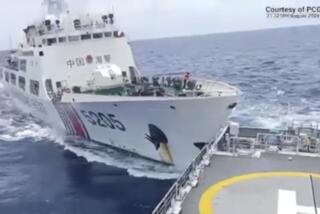‘Water on deck!’ ‘Get out!’ Navy investigation details mid-ocean collision that killed seven sailors
- Share via
Reporting from Washington — It was before dawn, and most of the ship’s crew lay asleep in their berths aboard the Fitzgerald, a U.S. destroyer, when suddenly the ocean flooded in on the starboard side and disaster loomed.
“Water on deck!” the sailors yelled. “Get out!”
Seawater poured in so fast that it was already waist-deep before the first of 42 sailors in the worst-affected room could climb to safety in the dark. Thirty-five made it. Seven did not.
Those harrowing details stood out in a 41-page Navy report on the collision between the Fitzgerald and a vastly larger container ship in calm seas in a shipping lane off the coast of Japan early on June 17, one of the worst naval accidents in years.
The commander and executive officer of the Fitzgerald were relieved from command Thursday and up to a dozen crew were disciplined, including the top enlisted sailor, for failing to avoid a mid-ocean crash with the ACX Crysta, a Philippine-flagged container ship.
Cmdr. Bryce Benson, commander of the Fitzgerald, and Cmdr. Sean Babbitt, the ship’s second-in-command, were fired from their positions because the Navy “lost trust and confidence in their ability to lead,” Adm. William F. Moran, vice chief of naval operations, told reporters Thursday.
It’s still unclear why the two huge ships didn’t see and avoid each other — an issue subject to another investigation — given modern radar and other sophisticated tracking marine gear, especially on the warship.
But the Navy said Vice Adm. Joseph Aucoin, commander of the 7th Fleet, had enough information to assign punishments for the collision, which occurred about 50 nautical miles southwest of the Japanese port of Yokosuka.
The predawn sky was still dark with scattered clouds when the ACX Crystal, which is 728 feet long and weighs 29,000 tons, smashed into the Fitzgerald, which is 505 feet long and 9,000 tons.
The crash carved a 13-by-17-foot gash into the Fitzgerald’s forward starboard side above and below the water line, where the sleeping area known as Berthing 2 was located.
The warship listed as it took on more water, while mattresses, furniture and other debris made sailors’ escape more difficult.
The skin of the ship and outer bulkhead were gone and the night sky could be seen through the hanging wires and ripped steel.
— Navy report
The last one rescued, who was in the bathroom when the ships collided, told investigators he was pinned between the lockers and the ceiling of Berthing 2. He grabbed a pipe in the ceiling to pull himself free.
Desperate, he swam to the only light he could see, taking a final breath before being saved.
“He was already submerged and breathed in water,” the report said, adding that the area flooded in 30 to 60 seconds.
With little visibility, sailors felt for other crew members as the cold water continued to rise. At the top of the ladder, they yelled into the flooded space below in an attempt to determine if anyone was still alive.
“No shadows were seen moving and no response was given,” the report said.
The survivors made the wrenching decision to close the watertight hatch to stop the flood of water pouring in. It also entombed those still below.
Benson, the ship’s captain, was trapped and injured in a nearby cabin. He was freed after sailors hit his door several times with a sledgehammer to break it from the hinges. They pushed debris out of the way and crawled in.
“The skin of the ship and outer bulkhead were gone and the night sky could be seen through the hanging wires and ripped steel,” the report said. “The rescue team tied themselves together with a belt in order to create a makeshift harness as they retrieved [Benson], who was hanging from the side of the ship.”
Keeping the ship afloat and getting it back to Yokosuka, home to the Navy’s 7th Fleet, took unusual efforts, the report said,
“Through their swift and, in many cases, heroic actions, members of the Fitzgerald crew saved lives,” the report said.
“No damage control efforts, however, would have prevented Berthing 2 from flooding completely within the first two minutes following the collision, or the deadly circumstances in that situation.”
The Japanese Coast Guard sent vessels to assist in rescue efforts while Japanese helicopters and a U.S. patrol aircraft flew near the destroyer.
Three sailors required medical evacuation, including Benson.
Twitter: @wjhenn
ALSO:
U.S. special operations forces face growing demands and increased risks
The U.S. is launching ‘danger-close’ drone strikes so risky they require Syrian militia approval
More to Read
Sign up for Essential California
The most important California stories and recommendations in your inbox every morning.
You may occasionally receive promotional content from the Los Angeles Times.














